





Do you love Japanese maples but don't have the space? Why not try growing them in conatiners! There are many dwarf to semi-dwarf cultivars that lend themselves beautifully to growing in pots. Nothing looks more elegant than a potted Japanese maple in a secluded courtyard or enclosed deck or just about anywhere! Read on to learn how to grow them and which selection work best.
It seems that these days gardens, as a whole, are becoming smaller. However, as gardeners, we want to grow as much diversity as possible. The way around this is by growing in containers. This is fine for annuals but becomes more challenging if you want to grow woody material. Not all trees and shrubs will take to containers. However, there is one very choice group of woody plants that are ideal; Japanese Maples.
If I only had room for one woody plant in a pot, it would be a Japanese maple (actually I have room for 5 so far, but will get more!). It is difficult to find a more elegant plant, especially among the weeping and dwarf varieties. Essentially, any Japanese maple (Acer palmatum) can be grown in a container, however, some will outgrow their pots more quickly than others. Large standard cultivars like ‘Bloodgood', ‘Moonglow', ‘Osakazuki', ‘Oshio-beni' and ‘Sango-kaku' might only last a few years before they will need moving into the open garden. However there are lots of dwarf and semi-dwarf cultivars (1 to 3 m mature heights) that lend themselves to long-term cultivation in pots. It helps tremendously that these maples have significantly slower growth rates when growing in pots and naturally have smaller root systems than many plants their size.
The main advantage of growing in containers is that you can move the pots around for maximum impact and if you move homes, you can take them with you! However, success in pots takes a little more work than growing them in the open garden. There are several things to keep in mind.
F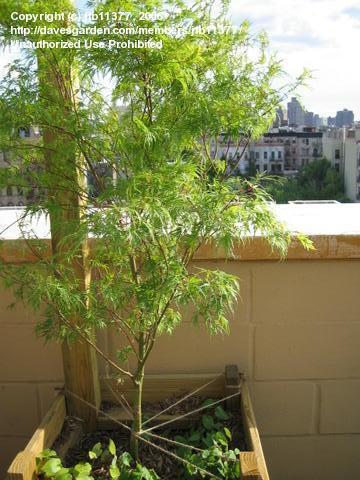 oremost is your hardiness zone. Japanese maples are rated for zone 5b. As a rule, container-grown plants loose one zone of hardiness so container-grown Japanese maples are really rated for zone 6b. If growing them in zone 5, then you should protect them in winter by plunging the pot in the ground or covering the pots in leaves for extra insulation. For gardeners in really cold zones, you can overwinter potted maples in an unheated garage or shed, as long as the temperature does not drop below -10 EC (Japanese maple roots are damaged at temperatures below this).
oremost is your hardiness zone. Japanese maples are rated for zone 5b. As a rule, container-grown plants loose one zone of hardiness so container-grown Japanese maples are really rated for zone 6b. If growing them in zone 5, then you should protect them in winter by plunging the pot in the ground or covering the pots in leaves for extra insulation. For gardeners in really cold zones, you can overwinter potted maples in an unheated garage or shed, as long as the temperature does not drop below -10 EC (Japanese maple roots are damaged at temperatures below this).
Next you need to select the right pot. It goes without saying that the pots must have adequate drainage holes. Ceramic pots probably look the most attractive. Do not use standard terra cotta as they will crack when exposed to frost. I use high-fired ceramic pots and after 10 years outside, have never had one break considering they are frozen for 4 months of the year! Remember that these pots can be heavy, especially once they are filled with a potted maple! Plastic pots are a safe choice and much lighter in weight. Some can look cheap, but there are ceramic look-alikes that can be very attractive. Large wooden planters look rustic but they should be lined in plastic or styrofoam so that the wet soil is not in direct contact with the wood. For stability, any container used should be wider than tall to lessen the risk of it becoming top-heavy. Place heavy pots on wheeled platforms for eas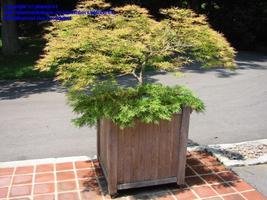 y movement. Also, if placed on wooden decks, elevate the pots by at least a couple of centimetres so that drainage is not impeded and to prevent damage to the deck by having a constantly wet pot sitting on it.
y movement. Also, if placed on wooden decks, elevate the pots by at least a couple of centimetres so that drainage is not impeded and to prevent damage to the deck by having a constantly wet pot sitting on it.
Next comes the soil. Pro-mix and other prepared potting soils may be fine for annuals but I have not had as much success with such soil for long-term plantings. I make my own soil from 2 parts topsoil, 2 parts organic material and 2 parts perlite or sand. To ensure the drainage holes don't clog, I place a 3-5 cm layer of crushed stone in the bottom of the pots. Plant the tree at the same depth as it was in its nursery pot.
You will need to water regularly as Japanese maples do not like drought conditions. You have two choices in fertilizing. You can use a slow-release granular fertilizer scratched into the soil surface in spring just before leaf break or you can fertilize regularly from spring until mid-summer with a water-soluble fertilizer. A 20-20-20 formula or equivalent works fine. As you are not trying to encourage extra growth, use fertilizers at half strength. Do not fertilize after the end of July as you may cause an unwanted late season flush of growth that may not harden properly before winter.
Once planted, you need to decide where the pot should be placed. Avoid windy and/or hot, sunny sites as both could result in ratty leaves. Morning or late afternoon sun with shade from midday sun is ideal. Potted Japanese maples are ideal for entranceways and patios but I also place them among low annuals and perennials to provide such plantings with some taller focal points.
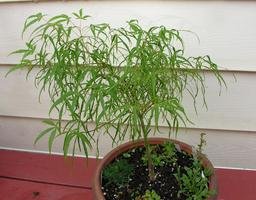
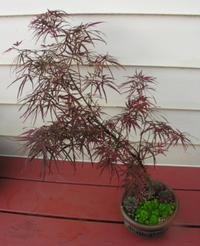
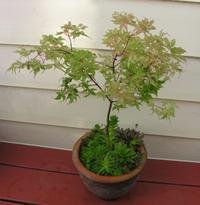
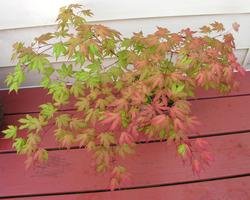
A selection of container grown maples: 'Koto-no-ito', 'Red Pygmy', 'Ukigumo' and 'Aka shigitatsu sawa'
As the trees grow, you may need to move them on to larger pots. This may be needed every year or two while the trees are young. Once they have matured (about 10 years old) you will need to root prune them every 2-4 years. Take them out of the pot in late winter-early spring (before leaf-break) and slice 7-10 cm from the bottom of the rootball, then take 3 or 4, 5-7 cm wedges from the side of the rootball. This seems drastic but will encourage the maple to send out new roots. It's the new rootlets that absorb water and nutrients; the larger roots are used mostly for anchorage.
Pruning may be needed as well. Always remove dead branches. Overlapping and rubbing branches should be removed from the upright types while the weeping varieties may need small, inner branches removed. Long growths should be trimmed back as well. All this should be done after the main flush of growth is complete. Winter pruning may lead to too much sap loss through bleeding.
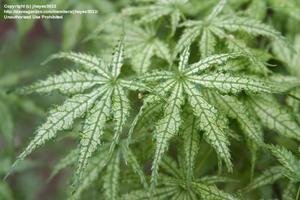
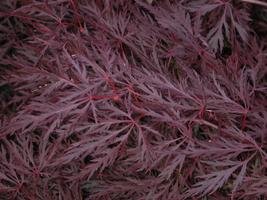
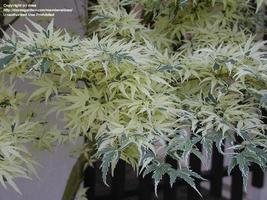
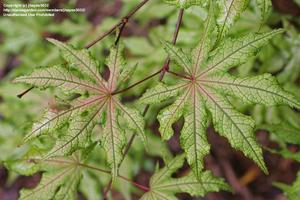
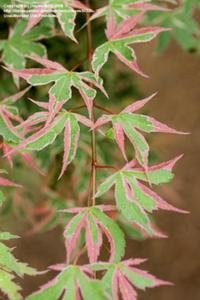
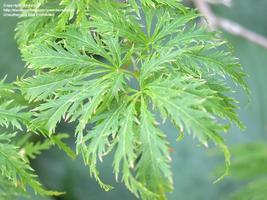
Foliage details of 'Peaches and Cream', 'Red Dragon', 'Butterfly', 'Aka shigitatsu sawa', 'Beni shichihenge' and 'Viridis'
Finally, if growing in a large enough container, you can underplant the maple with small bulbs and perennials for added interest. Make sure they are plants with small root systems that will not compete with the roots of the maple. I use sedum, hens and chicks, saxifrages, violets, dwarf pinks and bellflowers in mine.
The following is a list of 40 Japanese maple cultivars that will perform well as container-grown specimens. The list is based on personal experience, conversations with other Japanese maple growers and from books such as Japanese Maples by J.D. Vertrees and Maples by Rosemary Barrett. The list is not exhaustive and no doubt there are many others that will work. At the least, it will give you a good starting point if you desire to grow these wonderful trees in containers. You can refer to my 'Japanese Maples 101' article http://davesgarden.com/guides/articles/view/237/ for details on the various groups and terms used below.
Codes:
P = Palmatum group
A = Amoenum group
M = Matsumurae group
D = Dissectum group
L = Linearilobum group
U = upright habit
S = shrubby habit
C = cascading habit
Dw = Dwarf
Var = Variegated foliage
Cultivar
Habit
Spring
Summer
Fall
Akane
P, U,
orange
yellow-green
yellow to red
Akita yatsubusa
P, Dw, S
pinkish-red
green
orange-red
Baby Lace
D, Dw, S
reddish-orange
bronze-green
orange-red
Beni maiko
P, U
red
reddish-green
pink-red
Beni shichihenge
P, U, Var
orange-pink
green, white
orange
Brandt's Dwarf
P, Dw, S
plum-red
dark red
red
Brocade
D, C
red
reddish-green
red
Butterfly
P, U, Var
white, pink
white, pink, green
red
Caperci Dwarf
P, Dw, S
coral-pink
light green
gold
Crimson Queen
D, C
red
purple-red
red
Elizabeth
P, Dw, S
pink
purple-red
red
Filigree
D, C
yellow-green
cream specked green
gold
Garnet
D, C
orange-red
red
red
Geisha
P, Dw, S, Var
pink, cream
pink, cream, green
red
Globosum
P, Dw, S
yellow-green
green
yellow
Green Cascade
D, C
green
green
orange
Hoshi kuzu
P, Dw, S, Var
pinkish
cream specked green
yellow to red
Inaba shidare
D, C
red
purple-red
red
Kashima
P, Dw, S
bronze-green
light green
gold
Kotohime
P, Dw, S
orange-red
green
gold
Koto-no-ito
L, Dw, S
bronze-green
light green
gold
Omure yama
M, C
orange-green
yellow-green
orange
Orido nishiki
P, U, Var
pink-cream
pink and green
red
Peaches & Cream
P, U, Var
pink-cream
cream speckled green
yellow
Pixie
P, Dw, S
red
purple-red
red
Red Dragon
D, C
red
purple-red
red
Red Elf
P, Dw, S
red
purple-red
red
Red Pygmy
L, U
red
purple-red
red
Seigen
P, Dw, S
red
green
yellow to red
Seiryu
D, U
reddish-green
green
yellow to red
Shaina
P, U
red
purple-red
red
Sharp's Pygmy
P, Dw, S
reddish-green
green
red
Shigitatsu sawa
A, U
yellow-green
yellow-green
red
Shishigashira
P, Dw, S
green
green
gold
Tamuke yama
D, C
red
purple-red
red
Ukigumo
P, U, Var
pink-cream
pink speckled green
red
Villa Taranto
L, U
orange-red
purple-green
yellow
Waterfall
D, C
green
green
gold
Wilson's Pink Dwarf
P, Dw, S
pink
green
red
Viridis
D, C
green
gren
yellow
I would like to thank the following people for the use of their photos: doss ('Butterfly'), jhayes ('Peaches and Cream', 'Beni shichihenge' and 'Aka shigitatsu sawa'), jtb ('Seiryu'), pdb ('Waterfall') and daryl ('Viridis')
Copyright © www.100flowers.win Botanic Garden All Rights Reserved